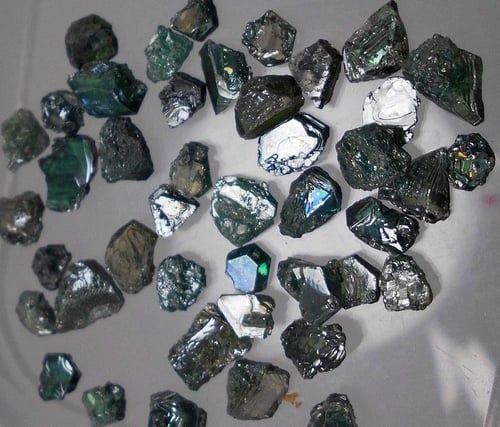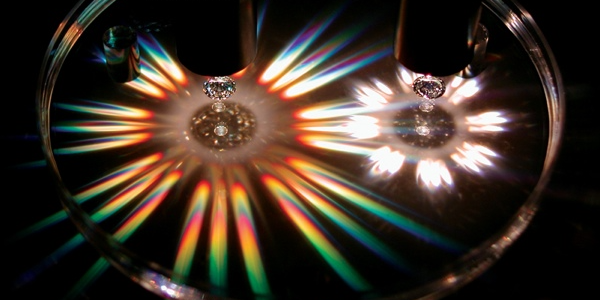You are getting ready to buy a diamond as a gift for that special someone, for an engagement ring, or even for yourself but you keep coming across one word which is "moissanite." When you see a peculiar gem along with this word, it looks exactly like a diamond and seems to be... cheaper. Now you start wondering to yourself, "What does this mean?"
This post will be covering:
- What is Moissanite exactly?
- The History of Moissanite
- Why Don’t We See Natural Moissanite Being Used?
- When Did Moissanite Start Being Artificially Created?
- Moissanite vs Diamond: Durableness
- Moissanite vs Diamond: Color
- Moissanite vs Diamond: Brilliance
- Moissanite vs Diamond: Price
- Which Should You Buy: Moissanite vs Diamonds?
Before we start we need to answer an important question:
What is Moissanite Exactly?
Most people today know moissanite as an artificially created gemstone formed by using silicon carbide, a “fake diamond” of sorts, or a more “environmentally friendly” alternative to natural diamonds. While this is technically true, moissanite can be found in nature. In fact, natural moissanite deposits are extremely rare, and most are actually otherworldly…literally.

The History of Moissanite
Natural moissanite was found near the remnants of an ancient meteor in Arizona by Dr. Henry Moissan, who mistakenly thought he had come by actual diamonds due to their similar appearance. Upon closer examination, in 1904, moissanite was discovered to have a different chemical composition than diamonds, instead of being comprised of carbon, it was made up of silicon carbide.
Why Don’t We See Natural Moissanite Being Used?
We don't see natural moissanite frequently because it is extremely rare. This rarity has made its use as a decorative gemstone very impractical and costly.
When Did Moissanite Start Being Artificially Created?
Due to its rarity, scientists started to artificially create moissanite during the 1980s. Successfully lab-grown moissanite gems actually seemed to outshine natural diamonds, all the while providing a more “environmentally friendly” alternative at a fraction of the cost.
Now that we know some basic information about moissanite, how does it really differ from natural diamonds?
Moissanite vs Diamond: Durableness
Diamond is the hardest known mineral to date, scoring a perfect 10/10 on the Mohs Scale of Hardness. Moissanite, while not as strong, still scored a very impressive 9.5/10, which is harder than sapphires and rubies, both of which scoring a 9. But why is the hardness of a mineral even taken into consideration when comparing gems? The harder stones are more durable, and thus harder to scratch or chip.
Moissanite vs Diamond: Color
Naturally mined diamonds come in a plethora of hues. There are crystal clear diamonds, diamonds with some light hues, and diamonds that are borderline a different color. This is mainly due to environmental factors that took place during the diamond's formation. Heat, pressure, the existence of other chemical impurities all play a role in the hue of natural diamonds.
The following scale was invented in order to properly grade and rate these diamonds:

Since all of the moissanite gems found in jewelry today are artificial, we will be comparing naturally clear diamonds to lab-grown moissanite. These artificial stones are created under ideal conditions, enabling their color to range between D and I, the two highest grades in the diamond color scale.
Moissanite vs Diamond: Brilliance
Everyone wants a shiny stone in their jewelry, and that is exactly what brilliance refers to. In essence, it is the ability of a gem to reflect light. Once again, due to the ideal and monitored conditions used to create moissanite, lab-grown moissanite crystals are able to refract light much better than natural diamonds. Additionally, their crystalline structure attracts less dirt and grease over time, so moissanite can potentially keep its “sparkle” for much longer than natural diamonds.

Moissanite vs Diamond: Price
Despite natural moissanite being extremely rare, lab-grown moissanite is not. Conversely, the extreme rarity of high grade diamonds coupled with their high demand makes them exponentially more expensive than moissanite.
When it comes to pricing, what are the differences in how each is priced? Diamond price is predicated on the 4Cs: Cut, Clarity, Color, and Carat weight. The higher each one of these elements scores, the rarer and more expensive the diamond. On the other hand, moissanite is priced based on its size and shape. The larger, more intricate looking the gem, the higher the price tag.
Which Should You Buy: Moissanite vs Diamonds?
Truthfully there is no right or wrong answer here. It comes down to personal preference and investment interest. If you are looking for an environmentally friendly, less expensive, and long-lasting stone go with moissanite. If you want something that has journeyed millions of years, is a rare one of a kind investment quality item, diamonds would be the clear winner.
Further Reading


